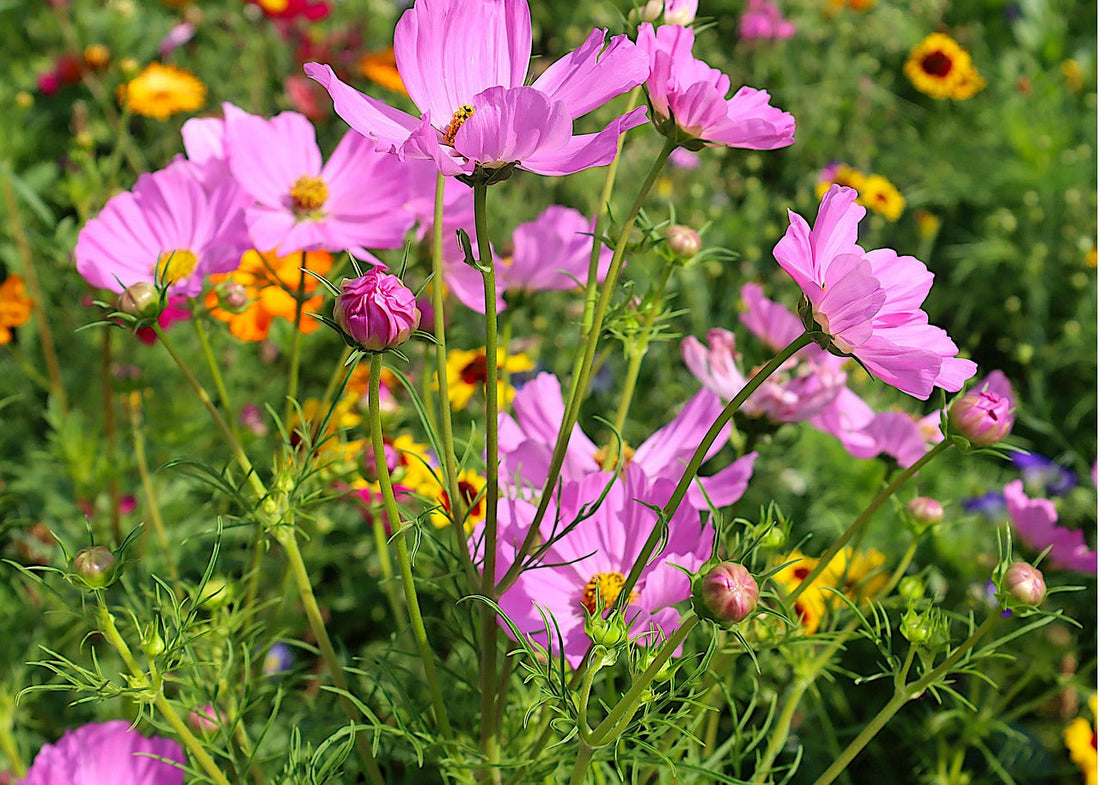
Cosmos -
Rachel MartinShare
What is there to love about Cosmos? Everything!
They stay in bloom for months: right through to the first frosts in faraway autumn. The more you cut them the more they flower – and those blooms will brighten up your garden, veg patch and vases in your home.
Cosmos are brilliant pollinator pleasers. Find them a spot in a container, your border or in the veg garden – they will earn their keep in any of these places. In the veg garden partner them up with the sturdier edibles – beans, courgettes, kale and sweetcorn – to form cottage garden style planting that brings benefits to all. Those lovely cosmos flowers draw in beneficial insects like lacewings and hoverflies that feed on many pest insects and provide free pollination services!
They are easy annuals: easy to sow and grow and flowering this year. They like a sunny position and once established they get on without lots of fussing. Resilient even in drought and survive if they get a bit neglected! In fact, too much care and attention, too much rich soil, can encourage lots of leafy growth rather than flowers so don’t plant in the best bits of your garden!
Now if you are worried that the soil in your veg garden will be too nice for cosmos then pop your precious seedlings into larger pots with a leaner fill and sink those pots among your veggies. We have used a low nutrient fill (seed compost rather than potting compost) remembering that cosmos can thrive in roadside plantings with little nutrients, in full sun, with no attention and surviving on rain and dew.
For more flowers and bushier plants all you need to do is pinch out the tops of your seedlings and the best time to do this is when they have grown three sets of true leaves (that is the fern-like leaves). Pinching out encourages plants to branch out, more branches and the plants have a bushier appearance and places for the flowers.
As a cut flower you can make beautiful bouquets or plonk a bunch in the nearest jar or vase to hand! Their vase life is 7-10 days, you can either sear the stems in boiling water or trim the stems back every few days and change the vase water. Remember to strip off any leaves on the part of the stems that will be in the water – those decaying leaves shorten vase life. Blooms picked earlier in the day contain more moisture so wilt more slowly. Ideally choose blooms with petals that are just starting to unfold, they will open fully once the stems are in water. Enjoy them yourself or share a bunch with friends.
You can dot cosmos around, wherever you have a gap, or plant as drifts. Those drifts and groups will actually attract more bees than individual plants… bees are very clever and know they use less energy flying from flower to flower when those blooms are close together.
Cosmos will add height and movement to your garden: those myriad flowers are wafting over lovely feathery foliage and if you are sitting down lots of that colour will be at your eye level: the three varieties in this month’s collection are 75-90cm tall. Play with colour and texture combinations… Try Cosmos Purity with Marigold Jolly Jester – the centre colour of Purity is picked up by the Marigold which flower slightly lower. Cosmos can help create a meadow effect – pair Candystripe with Verbena Bonariensis. Cosmos and dahlias bring colour and long-lasting blooms to gaps in your borders and both ought to be in a ‘cutting patch’, try Dahlia Bishop's Children with Cosmos Velouette for fiery richness.
That really is everything to love about Cosmos, and all the reasons to sow and grow them yourself!
Rachel
May 2025
